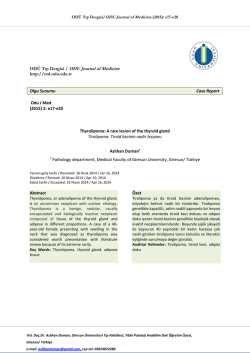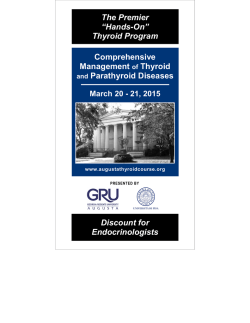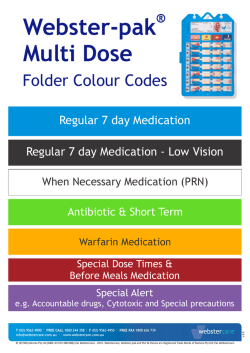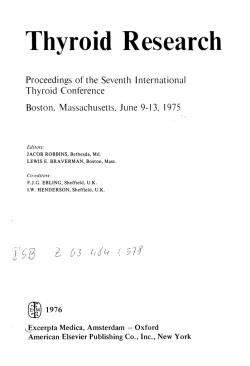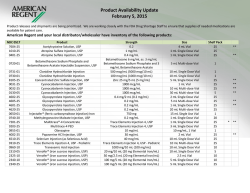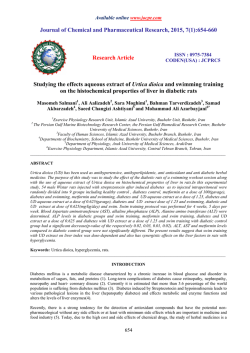
View Full Article - PDF - International Research Journals
International Research Journal of Engineering Science, Technology and Innovation (IRJESTI) (ISSN2315-5663) Vol. 4(1) pp. 1-4, January 2015 DOI: http:/dx.doi.org/10.14303/irjesti.2014.073 Available online http://www.interesjournals.org/IRJESTI Copyright © 2015 International Research Journals Full length research paper Dosimetric evaluation due to radiation in thyroid issued by Tc99m and I131 Vásquez AM1, Castillo DC2, Vasquez DJ3 , Rocha MD4, García RW5 National University of Trujillo. Av. Juan Pablo II s/n, Trujillo, Perú1, 2, 3, 4, 5 Corrsponding author email: [email protected] Abtract The absorbed dose in the thyroid uptake studies is estimated, by analysis of the biokinetics of radiopharmaceuticals containing the I-131 (iodide) or Tc- 99m (pertechnetate) Using the MIRD formalism and Cristy-Eckerman representation for adult thyroid patients, demonstrated that the dose absorbed by the gland due to emissions of I-131(iodide) is self - dose and is given by 340.9 mGy / MBq ; dosimetric contribution of organs that are part of its bio kinetics (excluding thyroid) is not significant in the estimated dose.The absorbed dose to the gland due to emissions of Tc-99mTc (pertechnetate) is 0.0234 mGy / MBq; 7.6% are organ dosimetry contributions that are part of its biokinetics (excluding thyroid), and is very significant in the estimated doses to be ignored Keywords: MIRD dosimetry, Cristy-Eckerman phantom, thyroid uptake, iodide and pertechnetate. INTRODUCTION The dose absorbed by the thyroid gland of an adult, for uptake studies, can be estimated by analyzing the biokinetics of radiopharmaceuticals used, containing I131(iodide) orTc- 99m pertechnetate MATERIAL AND METHODS To estimate the absorbed dose to the thyroid of adult patients, due to the dosimetric contributions biokinetics bodies, were used MIRD formalism and representation of Cristy-Eckerman to these organs. Medical Internal Radiation Dosimetry considered equations (Radiation doses received by patients following administration of radiopharmaceutical, 2013) k k (tiroides i) i rad / Ci A0 i1 k Dparticle(tiroidetiroide) [Eparticle tiroide Eparticle TB ]x2,13 rad/ Ci A0 mtiroide mTB Dfotones (tiroides ) TB Total residence time of the body mTB Total body mass The absorbed fractions, Φk (thyroid ← i) g¯¹, of "i" analyzed organs (organs biokinetics), for photon energies "k" of I-131 and Tc-99m were obtained from ORNL / TM8381 / V7 (Cristy MYK and Eckerman, 1987). Residence times of radiopharmaceuticals mentioned in each organ biokinetics given in Tables 1 and 2, were obtained from the website (Kinetic Models Used as the Basic for the Dose Estimates, 2013) k 2,13 n k E k ( rad gm ), Ci hr represents the average energy of the "k" photons emitted in the decay of I131 and Tc99m, given in Table 3, were obtained from web page (Radionuclide Decay Data 2013) E (MeV/des.), Represents the average energy of particles emitted by the I-131 and Tc-99m, ie represents the electrons appearing in the decay processes for capturing and Auger electrons are given in Table 4 and particle 2 Int. Res. J. Eng. Sci. Technol. Innov. Table 1: Residence times (hours) and bio kinetics of I-131 (iodide) (Kinetic Models Used as the Basic for the Dose Estimates, (2013) 0rgans of bio kinetics iodide Thyroid Stomach Small intestine Kidneys 60,72 1,66 1,66 0,095 ᵢ (hours) Bladder Rest of body 1,32 7,76 Table 2: Residence times (hours) and biokinetics of 99mTc (pertechnetate) (Kinetic Models Used as the Basic for the Dose Estimates,2013) Organs of bio kinetic. Iodide Thyroid Stomach ULI Content Kidney 0,037 0,154 0,743 0,033 ᵢ (horas) Rest of body ULI wall LLI content 4,32 0,54 0,363 Bladder 0,345 Table 3: Data for nuclear emitted photons (MeV) of I-131 and Tc-99m most significant (Radionuclide Decay Data 2013) RFM Photons Gamma I 131 Radiation Característic Gamma 99m Tc Radiation Característic Ek nk /des ( (Me V) 0,080 0,284 0,364 0,637 0,723 0,0295 0,0298 0,0336 0,14053 0,1426 0,0183 0,0184 0,0206 were obtained from web page (Radionuclide Decay Data 2013). Mass values thyroid and organ biokinetics were obtained from 0RNL / TM-8381 / V1 (Cristy MYK and Eckerman, 1987) and are given in Table 5 Using the MIRD methodology and Cristy-Eckerman representation thyroid of adult patients, the study is to demonstrate whether the dosimetric contributions organs that are part of the biokinetics of I-131 (iodide) and Tc-99m (pertechnetate), is significant in the estimated absorbed dose to the gland RESULTS The results are shown in Table 6 and show that: (1) The absorbed dose to the gland due to emissions from I-131 (iodide) is 340.9 mGy / MBq; 99.98% is self dose (90.06% to beta emissions, 3.76 %, conversion 0,026 0,06 0,817 0,0717 0,0177 0,0138 0,0256 0,009 0,8906 0,0002 0,021 0,040 0,012 k 2 ,13 n k E k rad gm ) Ci hr 0,0044 0,0363 0,6334 0,097 0,027 0,00088 0,0016 0,0006 0,2665 0,0001 0,0008 0,0016 0,0005 electrons, Auger electrons 0.15%, and the remaining 6.01%, due to the gamma / photon radiation characteristic). The dosimetric contribution of organs that are part of its biokinetics (excluding thyroid) is negligible (2) The absorbed dose to the gland due to emissions of Tc-99m (pertechnetate) is 0.0234 mGy / MBq, the 92.77% is self - dose (70.51% conversion electrons, 4.27% to Auger electrons, the remaining 17.99% of gamma / photon radiation characteristics). The dosimetric contribution of organs that are part of its biokinetics (excluding thyroid), is 7.26%, significant value to be ignore The results reported doses are consistent with results published in” Radiation Dose Estimates for Radiopharmaeuticals “(Radiation dose estimates for radiopharmaceuticals 2014) Depending on the type of radiopharmaceutical used and biokinetics, shall the significance of their contributions in Vásquez et al. 3 Table 4: Data for nuclear emitted particles (MeV) of I-131 and Tc-99m most significante (Radionuclide Decay Data 2013) nk Ek RFM Partícles Ek (MeV) Beta I131 Electron Conversion Electrons Auger 99m Electron Conversion Tc Electrons Auger 0,0694 0,0966 0,1916 0,283 0,0456 0,359 0,3299 0,2497 0,0034 0,0246 0,1195 0,1216 0,1375 0,1396 0,140 0,0016 0,0022 0,0155 nk /des 0,021 0,073 0,899 0,0048 0,0354 0,0025 0,0155 0,003 0,051 0,006 0,088 0,0055 0,0107 0,0017 0.0019 0,746 0,102 0,0207 (MeV / des) 0,00145 0,007 0,1722 0,00135 0,0016 0,00089 0,0051 0,00075 0,00017 0,000147 0,01052 0,00067 0,0015 0,00024 0,00026 0,0012 0,00022 0,00032 E particle nkEk (MeV / des) 0,182 0,0076 0,000317 0,01439 0,00054 Table 5: Mass values (g) for thyroid and whole body of an adult Cristy -Eckerman representation (Cristy and Eckerman, 1987) Masa (gramos) Tiroides Cuerpo total (TB) Adulto 20,7 73700 Table 6: Absorbed dose to the thyroid of adult, due to I-131 and Tc-99m in the representation Cristy - Eckerman and MIRD formalism (mGy / MBq) RFM I 131 (iodide) 99m Tc (pertecnetate) emissiones Photons: γ X Emission Beta e- conversión e Auger Photons: γ X e- conversión e Auger D(thy ← thy)/Ao 19,84 0,69 307,03 12,82 0,52 0,0037 0.00051 0,0165 0,001 D(thy←i)/Ao* 0,05 0,006 Sub-total - 320,37 0,00167 0.000043 0.0059 - 0,0175 TOTAL 20,53 340,9 0,0234 (*) i = all source organs except the thyroid the estimated absorbed dose to the thyroid gland (Quimby and Feitelberg, 1970) CONCLUSIONS Using the formalism MIRD and Cristy - Eckerman representation thyroid of adult patients, it is shown that for studies of thyroid uptake, the dosimetric contribution of organs that are part of the biokinetics of I-131 (iodide), excluding the thyroid is not significant in the estimated dose; while the dosimetric contribution of organs that are part of the biokinetics of Tc-99m (pertechnetate), 4 Int. Res. J. Eng. Sci. Technol. Innov. excluding the thyroid, is very significant in the estimated absorbed dose to the patient to be ignored. REFERENCES Radiation doses received by patients following administration of radiopharmaceutical”,aabymn.org.ar/archivos/dosisradiacion.pdf (2013). Cristy MYK, Eckerman (1987). “Specific absorbed fractions of energy at various ages from internal photons Sources”, Oak Ridge, TN: ORNL/TM-8381 / V7 Kinetic Models Used as the Basic for the Dose Estimates, www.doseinfo-radar.com/NMdoses.xls (2013). Radionuclide Decay Data”, http://hps.org/publicinformation/radardecaydata.cfm (2013). Cristy MYK, Eckerman (1987). “Specific absorbed fractions of energy at various ages from internal photons Sources”, Oak Ridge, TN: ORNL/TM-8381 /V1 Radiation doseestimates for radiopharmaceuticals”, orise.orau.gov/files/reacts/dosetables.pdf (2014) Quimby E, Feitelberg SYW (1970). Gross “Radiactive Nuclides in Medicine and Biology”, Third edition, Lea & F. Philadelphia P.D.:Work exhibited in 18th International Conference on Medical Physics ICMP2011. Brazilean Journal of Medical Physics, www.abfm.org.br/rbfm/publicado/RBFM_digital.pdf (2011).
© Copyright 2025
